Marcia Thornton Jones's Blog, page 18
July 8, 2024
"Contemplating Mysteries" by Jane Kelley
 The Grand Canyon obscured by a foggy veil.
The Grand Canyon obscured by a foggy veil.The important thing is not to stop questioning. Curiosity has its own reason for existing. One cannot help but be in awe when he contemplates the mysteries of eternity, of life, of the marvelous structure of reality. It is enough if one tries merely to comprehend a little of this mystery every day. Never lose a holy curiosity. -- Albert Einstein
"Be in awe! Contemplate the mysteries!" I love that quote. I especially love that Albert Einstein was the one who said it. One of the greatest scientific minds of all time also appreciated the other kind of thinking. Maybe divide between the left-brain and the right-brain isn't so wide after all?
Why did he urge us to keep questioning? Today curiosity takes the form of an internet search. Answers to any mundane question is instantly available. How often have I done that in my writing -- provided a factoid when contemplating a mystery was what my story needed.
A painting with mystery retains the brain's attention long enough for something deeper to happen - an emotional connection, perhaps. -- Brian Crawford Young.
Obviously we can't frustrate our readers by making our stories too confusing. But if we leave some space, then readers will wonder.
One of my WIP recently received this comment from another writer.
"I can’t decide what is happening, but I’d keep turning the pages to find out.”
This particular WIP is Speculative Fiction. But then, I think ALL fiction is about speculation. We should wonder why a spider would save a pig, why a mouse would think he could rescue a princess, why anyone would do anything.
Remember what Einstein said.
Never lose a holy curiosity!
Jane Kelley writes Middle Grade novels and essays to discover what she thinks.
@font-face {font-family:"Cambria Math"; panose-1:2 4 5 3 5 4 6 3 2 4; mso-font-charset:0; mso-generic-font-family:roman; mso-font-pitch:variable; mso-font-signature:-536870145 1107305727 0 0 415 0;}@font-face {font-family:Aptos; panose-1:2 11 0 4 2 2 2 2 2 4; mso-font-charset:0; mso-generic-font-family:swiss; mso-font-pitch:variable; mso-font-signature:536871559 3 0 0 415 0;}p.MsoNormal, li.MsoNormal, div.MsoNormal {mso-style-unhide:no; mso-style-qformat:yes; mso-style-parent:""; margin:0cm; mso-pagination:widow-orphan; font-size:12.0pt; font-family:"Aptos",sans-serif; mso-ascii-font-family:Aptos; mso-ascii-theme-font:minor-latin; mso-fareast-font-family:Aptos; mso-fareast-theme-font:minor-latin; mso-hansi-font-family:Aptos; mso-hansi-theme-font:minor-latin; mso-bidi-font-family:"Times New Roman"; mso-bidi-theme-font:minor-bidi;}.MsoChpDefault {mso-style-type:export-only; mso-default-props:yes; mso-ascii-font-family:Aptos; mso-ascii-theme-font:minor-latin; mso-fareast-font-family:Aptos; mso-fareast-theme-font:minor-latin; mso-hansi-font-family:Aptos; mso-hansi-theme-font:minor-latin; mso-bidi-font-family:"Times New Roman"; mso-bidi-theme-font:minor-bidi; mso-font-kerning:0pt; mso-ligatures:none;}div.WordSection1 {page:WordSection1;}
July 3, 2024
Writing is a Mystery by Irene Latham
For me, writing is a mystery. And the joy of writing is often found in the mystery, which is something we plotters/planners/excellent time managers must leave room for.
Not only must we leave room for mystery, we must cultivate mystery.
I love this quote from the great Sufi poet Rumi:
"Sell your cleverness and buy bewilderment."
Yes! We writers often spend too much time in cleverness (left brain) when what we need is more mystery, bewilderment (right brain).
 In his book My Trade is Mystery: Seven Meditations from a Life in Writing, Carl Phillips writes:
In his book My Trade is Mystery: Seven Meditations from a Life in Writing, Carl Phillips writes:"I've no idea how I do this thing, ultimately. Nor do I want to know. To be given a map or compass would prevent me getting lost – what, for me, the making of poems requires from the start; the act of writing is a way of finding a way forward into the next clearing, as a temporary stay against the inevitable next stretch of wilderness, where with luck the next poem lies hidden."
I'll leave you with an original (haiku) poem that includes a bit of mystery. Thanks so much for reading!
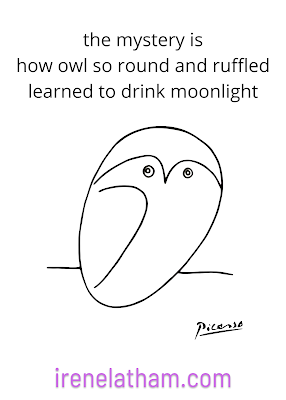
p.s. I can't write about mystery and not think of the film Shakespeare in Love. "It's a mystery!"
July 2, 2024
Midsummer Middle-Grade Reading
Midsummer Middle-Grade Reading
My favorite childhood memories usually center around reading--the excitement of a new stack of books from the library, the ability to immerse myself in the characters' worlds.
All these decades later, I still feel the same way! On my blog Book Q&As with Deborah Kalb this month, I interviewed some middle grade authors whose books would fit the bill for satisfying midsummer reading.
 Laura Segal Stegman is the author of The Chambered Nautilus, the third in her Summer of L.U.C.K. trilogy. I asked if her three characters--Darby, Justin, and Naz--had changed over the course of the series. "Yes, very much so, and not only because the trilogyspans three summers," she said. "They each come to camp struggling with communicating invarious ways. By the end of Summer of L.U.C.K., they've found their voices andformed an enduring friendship with each other and the ghostly Mr. Usher. Ready or Not is told from Justin's point of view as helearns to stand up to a bully, building leadership skills that carry over toThe Chambered Nautilus's story. And in the third book, the three kids learnthat their close friendship need not take away from their ability to growseparately into who they want to be."
Laura Segal Stegman is the author of The Chambered Nautilus, the third in her Summer of L.U.C.K. trilogy. I asked if her three characters--Darby, Justin, and Naz--had changed over the course of the series. "Yes, very much so, and not only because the trilogyspans three summers," she said. "They each come to camp struggling with communicating invarious ways. By the end of Summer of L.U.C.K., they've found their voices andformed an enduring friendship with each other and the ghostly Mr. Usher. Ready or Not is told from Justin's point of view as helearns to stand up to a bully, building leadership skills that carry over toThe Chambered Nautilus's story. And in the third book, the three kids learnthat their close friendship need not take away from their ability to growseparately into who they want to be."
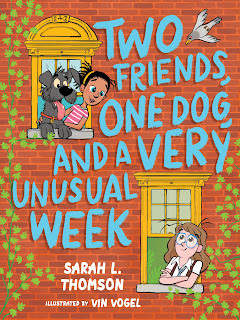 Sarah L. Thomson wrote Two Friends, One Dog, and a Very Unusual Week. I asked about the inspiration for the novel, and she said, "The Pippi Longstocking stories were a favorite when I wasgrowing up. I was a goody two-shoes as a kid (and to be honest, I still kind ofam). That’s probably why I loved Pippi so much—a fearless free spirit who’snever even heard of a rule!" She added, "I began to wonder how a Pippi-like character would fare intoday’s society, where kids have much less freedom than they did back in 1945,when Astrid Lindgren created Pippi. Rani popped into my head, perched in anarmchair aboard a moving van—and Two Friends got its start."
Sarah L. Thomson wrote Two Friends, One Dog, and a Very Unusual Week. I asked about the inspiration for the novel, and she said, "The Pippi Longstocking stories were a favorite when I wasgrowing up. I was a goody two-shoes as a kid (and to be honest, I still kind ofam). That’s probably why I loved Pippi so much—a fearless free spirit who’snever even heard of a rule!" She added, "I began to wonder how a Pippi-like character would fare intoday’s society, where kids have much less freedom than they did back in 1945,when Astrid Lindgren created Pippi. Rani popped into my head, perched in anarmchair aboard a moving van—and Two Friends got its start."
 Caroline Palmer's new book is the graphic novel Camp Prodigy. I asked Palmer about whether they began with the text or the illustrations--or worked on both simultaneously. "There was some overlap, but I came upwith the story in a good amount of detail before starting to draw it out," they said. "A lot of people have the two processesseparated; they’ll write out a script (like a movie!) before drawing anythingat all. I find it hard to work that way. After all, comics are a combination ofwords and art–when words aren’t enough, art can be relied on, and vice versa. All this to say, I like to work out thedialogue and pages simultaneously via thumbnail sketches. I feel like mystories have better pacing that way."
Caroline Palmer's new book is the graphic novel Camp Prodigy. I asked Palmer about whether they began with the text or the illustrations--or worked on both simultaneously. "There was some overlap, but I came upwith the story in a good amount of detail before starting to draw it out," they said. "A lot of people have the two processesseparated; they’ll write out a script (like a movie!) before drawing anythingat all. I find it hard to work that way. After all, comics are a combination ofwords and art–when words aren’t enough, art can be relied on, and vice versa. All this to say, I like to work out thedialogue and pages simultaneously via thumbnail sketches. I feel like mystories have better pacing that way."
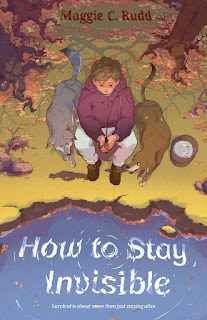 Maggie Rudd is the author of How to Stay Invisible. When I asked about the inspiration for her novel and for her protagonist, Raymond, she said, "I was walking through the woods behind the school where Iworked, and I saw a huge fallen tree. The roots were ripped up from the earthand there was a huge hole through the center of the root system. I stuck myhead inside to get a better look, and I thought, Wow, someone could live inhere. The thought bloomed and blossomed and turned into a book. The character, Raymond, is loosely based off of severalstudents whom I consistently worried about, but he definitely developed intohis own person with his own unique personality and problems."
Maggie Rudd is the author of How to Stay Invisible. When I asked about the inspiration for her novel and for her protagonist, Raymond, she said, "I was walking through the woods behind the school where Iworked, and I saw a huge fallen tree. The roots were ripped up from the earthand there was a huge hole through the center of the root system. I stuck myhead inside to get a better look, and I thought, Wow, someone could live inhere. The thought bloomed and blossomed and turned into a book. The character, Raymond, is loosely based off of severalstudents whom I consistently worried about, but he definitely developed intohis own person with his own unique personality and problems."
Happy summer reading!
--Deborah Kalb
June 30, 2024
I Really Need to Get Going (Holly Schindler)
I really need to finish drafting this year’s Ruby’s Place installment.
I really need to find some art directors to submit to.
I really need to finish my first font.
I really need to list my latest greeting card on Etsy.
I really need to enter Spoonflower’s latest design challenge.
I really need to finish that floral illustration course.
And the Illustrator course.
And the photography course.
And there will always be another group of really needs after these are done, so many of them that today, the best thing to do was lie beneath the sweetgum tree on a sweet June day and watch the clouds above turn summersaults.

~
Holly Schindler is the author of the MG The Junction of Sunshine and Lucky. She is also running a series on plotting through character (rather than action) on her Substack.
June 28, 2024
What Color Is Your Sky?
by Charlotte Bennardo
 Photo by Francesco Ungaro: https://www.pexels.com/photo/blue-sky...
Photo by Francesco Ungaro: https://www.pexels.com/photo/blue-sky...When I see a blue sky undisturbed by clouds or planes or trees, I see infinity. And as a writer, that means infinite possibilities. I just wrote a short story about a seed pod I saw on a trail as I hiked. I heard a snip of conversation, and an idea for a novel hit me. I would need to be immortal to use all the ideas crowded my head- and the ones fighting their way in.
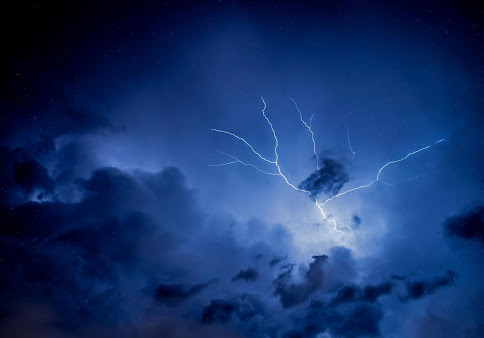 Photo by Rodrigo Souza: https://www.pexels.com/photo/photo-of...
Photo by Rodrigo Souza: https://www.pexels.com/photo/photo-of...Then there are dark skies... a portent of bad things to come. Like storms, there is no avoiding hard times, everyone gets a turn at the bottom of the barrel at some point. That's life, and writers use the experience of bad times in their writing. It helps us deal, process, and make sense of hardships. It allows our readers to feel a kinship with us because we share the same struggles and pain.
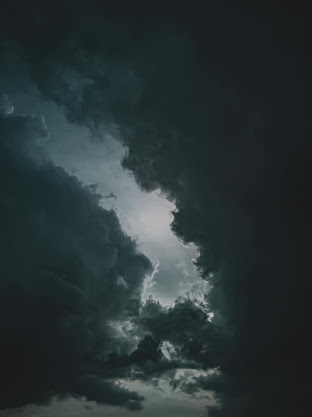 Photo by Alex Conchillos: https://www.pexels.com/photo/dark-clo...
Photo by Alex Conchillos: https://www.pexels.com/photo/dark-clo...Then, there are times when everything looks gray; we're not sure of our direction, of our work, of the next sentence. It's hard to see the next step. Uncertainty clouds our thoughts and actions, making us hesitate. We need to step back and evaluate, work through the issues, toward the light and a clear path.
 Photo by Fillipe Gomes: https://www.pexels.com/photo/photo-of...
Photo by Fillipe Gomes: https://www.pexels.com/photo/photo-of...Most of the time, our skies are partly cloudy or partly sunny- which means there are obstacles, but also moments of clarity. Maybe we're editing a book and suddenly realize where a revision is needed. Or maybe we're working through writer's block and get an idea. Yes, there's work to be done but like a partly sunny sky, there will be moments when our path is unobstructed.
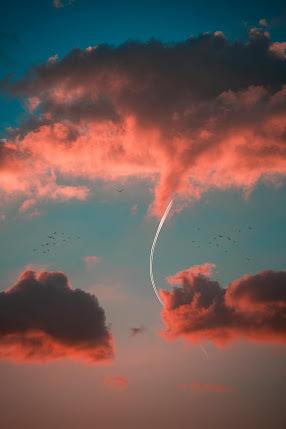 Photo by Ömer Aydın: https://www.pexels.com/photo/pink-clo...
Photo by Ömer Aydın: https://www.pexels.com/photo/pink-clo...Sometimes skies burst with color-dark, light, bright, dull, soothing, energizing- kind of like the moods, emotions, foreshadowing, and depths of our characters, plots, and settings which color our writing. Just as the colors in the sky make a resplendent sunrise or sunset, variations of writing elements help us create stories that are rich and engaging.
No matter what our 'sky' looks like, we can use what we see in what we write.
Charlotte writes MG, YA, NA, and adult novels in sci fi, fantasy, contemporary, and paranormal genres. She is the author of the award-winning middle grade Evolution Revolution trilogy, Simple Machines, Simple Plans, and Simple Lessons. She co-authored the YA novels Blonde OPS, Sirenz, and Sirenz Back in Fashion. She has two short stories in the Beware the Little White Rabbit (Alice through the Wormhole) and Scare Me to Sleep (Faces in the Wood) anthologies. Having finished her MFA, she's applying what she learned and is working on several children's and adult novels, along with some short stories. She lives in NJ with her family and her floofy cat. When they trimmed the backyard tree, the crazy squirrel couple had to move out, but she is happy to report she has a new squirrel tenant along with a new pet rabbit (Bad Bunny).
June 23, 2024
The Heady Cocktail of Sense Mixing: Smack Dab in the Imagination by Dia Calhoun
One of my favorite writing practices to open my imagination is the heady cocktail of sense mixing. Begin by taking an object--a lavender flower for example and describing what your eyes see. Next, describe how the lavender smells, tastes, feels, sounds. Wait, a minute, I can hear you ask, what do you mean, what a lavender sound like? Yes. This is where it gets interesting because we head to simile and metaphor, opening the imagination.
Brainstorm:
Lavender sounds like drunken bees.
Lavender sounds like my bare feet running out into a summer morning.
Lavender sounds like a dream where I am wide awake.
You can take this further. For example, write a paragraph that describes green without ever saying the word green. When you are stuck in your writing, take one of the important images from the poem, or scene, or book, or simply something that strikes you, and try this practice. You will be surprised at the results. Some wise person said, and I paraphrase, no surprise for the writer, no surprise for the reader. Keep it fresh.
June 15, 2024
What Comes Next?
I really enjoyed Holly’s recent newsletter, “I Really Need to Get Going.”
It can be overwhelming, when listing all the things oneneeds to do.
“[But] there will always be another group of reallyneeds after these are done,” Holly offers. And, she adds, “[However] today,the best thing to do was lie beneath the sweetgum tree on a sweet June day andwatch the clouds above turn summersaults.”
I’m looking ahead, planning out what I need to do for this next phase of life. Getting through all the paperwork feels oddly familiar, like grading papers. Then I realized …
I’ve been teaching forty years. FORTY years. FORTY ***YEARS!
I've taught at high school, community college, universityand graduate schools. I’ve taught English as a Second Language, BritishLit, Children's Lit, Writing Tech Reports, Critical Theory, and Harry Potter(yes, Harry Potter and the hero’s journey!). I've taught Critical Research, GraduateResearch Strategies, Graduate Reading Strategies. Business Writing. CreativeWriting. Graduate Thesis Writing one, two and three. Graduate LiteratureStudies. The Business of Writing. Editing and Line-editing. Composition one andtwo, and three.
And, I earned all the relevant certifications to keep going.BUT I didn’t make tenure because I was too old, and didn’t – couldn’t -- createa strong sense of community among the full-timers (because I was too crazy busy trying to keep a roofover my head and paying for my own medical insurance.) Still, one director didjust send me a cute little cup to celebrate 20 plus years at one department.
(By the way, adjuncts hold the system together. I could goon, but I'd get rather frothy about how the system treats adjuncts...)
After reading Holly’s list of things that need to be done, andwhat really needs to be done, I realized I survived for forty years, on my own,keeping a cabin’s roof over my head for most of those years, making my own way doing (mostly) what Iwant beyond what I need. May not always have been the wisest of choices, butthey’ve always been my choices. No wonder I’ve grown up to be such a roguish –and unmuzzled -- loggerhead.
So, what am I going to do next? Whatever I want. Thepossibilities are endless. Maybe I’ll be a pirate. And watch the clouds.

Photo: Mary Read, in a colorized engraving (date unknown). Getty Images / Hulton Archive
Wishing you many summer adventures!
--- Bobbi Miller
June 12, 2024
Unlimited Possibilities by Darlene Beck Jacobson
What do you think of when you look up at the sky? Is it the weather, like Jane Kelly mentioned in her post on Sunday? Color, or lack of? Or do you only look up when you hear an airplane or a flock of geese flying overhead?

I see the sky as a place of unlimited possibilities. Looking up allows us to imagine just about anything. We can be someplace else, cruising on the wind, allowing it, and our imaginations, to take us to places we've never seen or been to before.
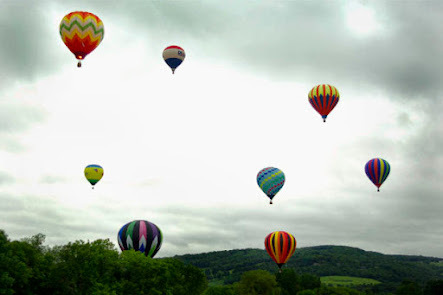
There is no beginning or end to sky. It is limitless and open. A perfect metaphor for the mind of a writer.
Imagine the possibilities of being there up in the sky...
Where would you go? What would you see from that vantage point? Not from inside an airplane, but from the air itself. How would it feel to be one with the sky? A bird.

If a bird had the power of storytelling, what wondrous tales would it tell?
LOOK UP.
IMAGINE THE POSSIBILITIES.
Darlene Beck Jacobson often daydreams of what it would be like to travel the sky, notebook in hand, looking for inspiration. But alas, she does her writing from the earth. Some of her favorite earth-bound places are the beach, woodland trails, under trees, and surrounded by nature.
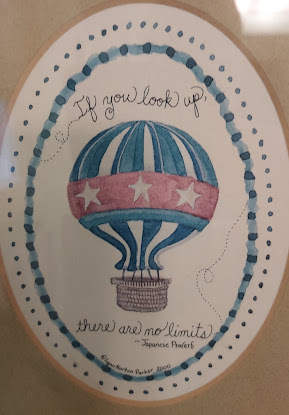
June 11, 2024
No Matter the Skies

Some days my imagination seems limitless like the skies that open to the Milky Way, believing there exist infinite possibilities inside this vast universe.
 Then, there are those days when every ounce of my creativity is shrouded in a fog that seems as if it will never part.
Then, there are those days when every ounce of my creativity is shrouded in a fog that seems as if it will never part. Those are the days when I swaddle myself with the feelings and insights my characters must embrace to become real people in my writing world. Those are the times when characters crawl out from their cliches and develop their personalities, their voices, their sense of purpose. Those are the moments when the fog lifts and the infinite seems possible again.
When she posted this, Jody Feldman found herself emerging from the fog but not quite in the limitless stage...yet. She knows it always comes.
June 8, 2024
GIVE ME CLOUDS -- by Jane Kelley
Blue skies.

Without that bit of cloud and tree, would you even know what the photograph is? Does it inspire you in anyway -- except to wonder why I took it and why it's in my blog?
Don't misunderstand me. I love a blue sky! I love when the sun shines on me. Especially if it's an important day with important outdoor plans that did not include any contingencies.
There was no blue sky on June 14, 1986. It rained all day. Lee and I couldn't get married on the shores of Lake Michigan as we planned. Instead, we got married in my parents' living room. Five hours later, we made our guests walk down a muddy path so that we could repeat our vows on the beach. Thirty-eight years later, we are still talking about a day made even more memorable by the clouds that refused to part.
An important aspect of the story is that I refused to even consider renting a tent. How could I be so stubborn? The wedding was to take place in Wisconsin where any day has a fifty-fifty chance of rain. But I was blue-skying. In business jargon, that means being optimistic. Refusing to be inhibited by realities. By ignoring limitations, blue-skying does encourage creative thinking. However some say blue-skying doesn't cause plausible business ventures--just those dreamed up by entrepreneurs who aren't in touch with reality.
Hmm. Like writing middle-grade fiction?
Speaking of. . ..
Let's reconsider the concept. Instead of blue skies -- a seemingly limitless view of the heavens -- let's add some clouds. Think of them as reality. Not to prevent something from being created -- but instead to make that creation accountable. Who is the reader? Who is the market? Have I actually communicated the things I want to say?
Clouds also provide drama. Obstacles. Contrast. Beauty. Suspense.

Would the rain stop long enough for Jane and Lee to say "I do!"

The rosy stripe along the horizon said yes.
Jane Kelley will soon be celebrating her 38th anniversary -- in a cave! Where the sky won't be visible at all. When she is writing, she will keep blue-skying with an appropriate sprinkle of clouds.



